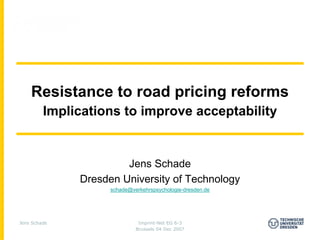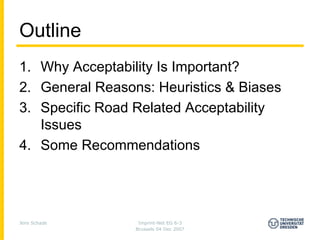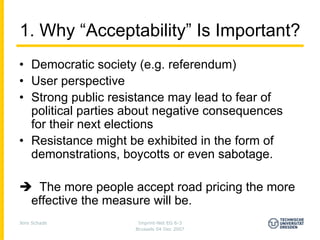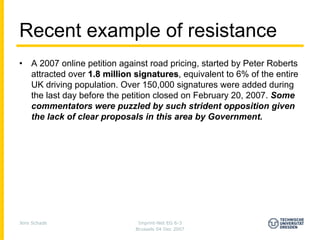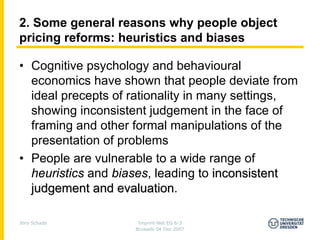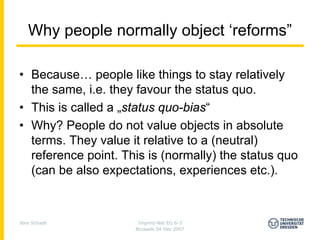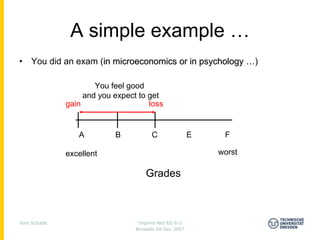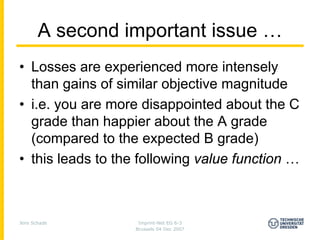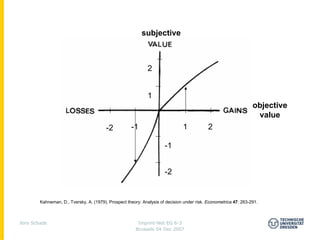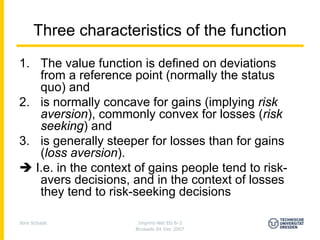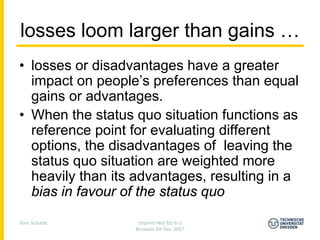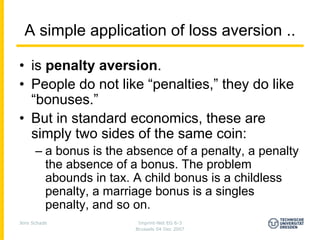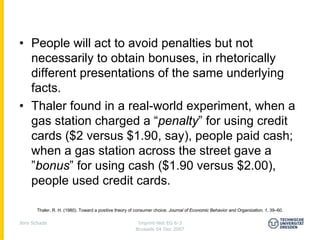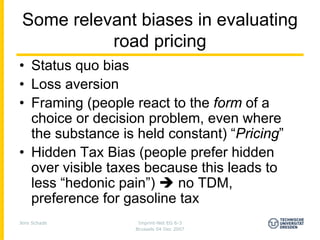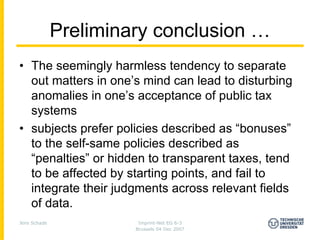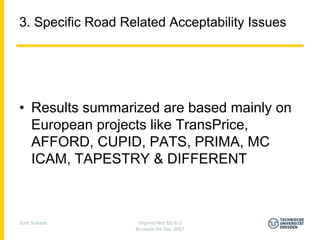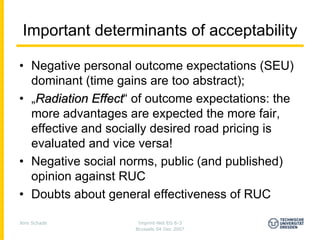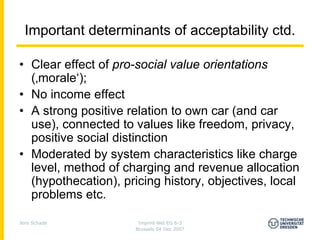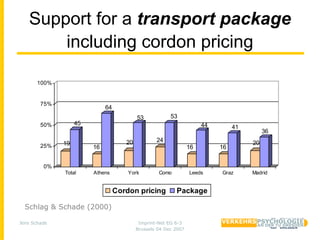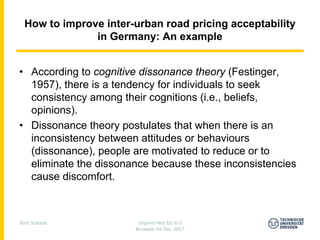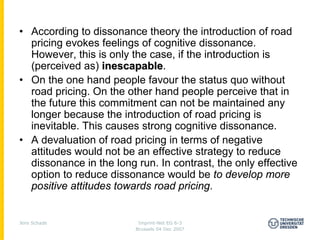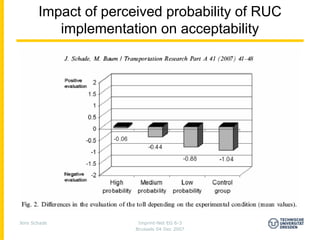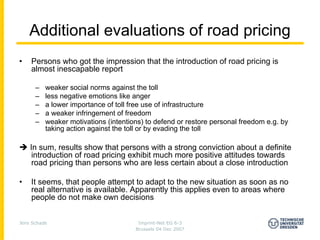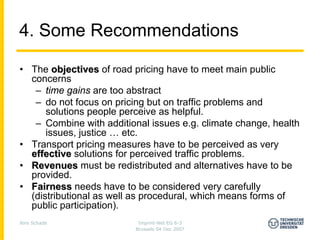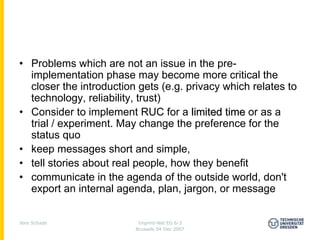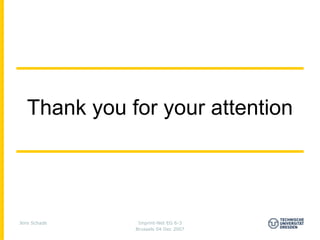Regarding The Acceptability Of Road Pricing
- 1. Resistance to road pricing reforms Implications to improve acceptability Jens Schade Dresden University of Technology schade@verkehrspsychologie-dresden.de Jens Schade Imprint-Net EG 6-3 Brussels 04 Dec 2007
- 2. Outline 1. Why Acceptability Is Important? 2. General Reasons: Heuristics & Biases 3. Specific Road Related Acceptability Issues 4. Some Recommendations Jens Schade Imprint-Net EG 6-3 Brussels 04 Dec 2007
- 3. 1. Why “Acceptability” Is Important? • Democratic society (e.g. referendum) • User perspective • Strong public resistance may lead to fear of political parties about negative consequences for their next elections • Resistance might be exhibited in the form of demonstrations, boycotts or even sabotage. The more people accept road pricing the more effective the measure will be. Jens Schade Imprint-Net EG 6-3 Brussels 04 Dec 2007
- 4. Recent example of resistance • A 2007 online petition against road pricing, started by Peter Roberts attracted over 1.8 million signatures, equivalent to 6% of the entire signatures UK driving population. Over 150,000 signatures were added during the last day before the petition closed on February 20, 2007. Some commentators were puzzled by such strident opposition given the lack of clear proposals in this area by Government. Jens Schade Imprint-Net EG 6-3 Brussels 04 Dec 2007
- 5. 2. Some general reasons why people object pricing reforms: heuristics and biases • Cognitive psychology and behavioural economics have shown that people deviate from ideal precepts of rationality in many settings, showing inconsistent judgement in the face of framing and other formal manipulations of the presentation of problems • People are vulnerable to a wide range of heuristics and biases, leading to inconsistent judgement and evaluation. evaluation Jens Schade Imprint-Net EG 6-3 Brussels 04 Dec 2007
- 6. Why people normally object ‘reforms” • Because… people like things to stay relatively the same, i.e. they favour the status quo. • This is called a „status quo-bias“ • Why? People do not value objects in absolute terms. They value it relative to a (neutral) reference point. This is (normally) the status quo (can be also expectations, experiences etc.). Jens Schade Imprint-Net EG 6-3 Brussels 04 Dec 2007
- 7. A simple example … • You did an exam (in microeconomics or in psychology …) You feel good and you expect to get gain loss A B C E F excellent worst Grades Jens Schade Imprint-Net EG 6-3 Brussels 04 Dec 2007
- 8. A second important issue … • Losses are experienced more intensely than gains of similar objective magnitude • i.e. you are more disappointed about the C grade than happier about the A grade (compared to the expected B grade) • this leads to the following value function … Jens Schade Imprint-Net EG 6-3 Brussels 04 Dec 2007
- 9. subjective 2 1 objective value -2 -1 1 2 -1 -2 Kahneman, D., Tversky, A. (1979). Prospect theory: Analysis of decision under risk. Econometrica 47: 263-291. Jens Schade Imprint-Net EG 6-3 Brussels 04 Dec 2007
- 10. Three characteristics of the function 1. The value function is defined on deviations from a reference point (normally the status quo) and 2. is normally concave for gains (implying risk aversion), commonly convex for losses (risk seeking) and 3. is generally steeper for losses than for gains (loss aversion). I.e. in the context of gains people tend to risk- avers decisions, and in the context of losses they tend to risk-seeking decisions Jens Schade Imprint-Net EG 6-3 Brussels 04 Dec 2007
- 11. Loss Aversion • loss aversion refers to the tendency for people to strongly prefer avoiding losses than acquiring gains. Many studies suggest that losses are as much as twice (or even more) as psychologically powerful as gains • The aversion to loss means that people are willing to take more risk to avoid losses than to make gains! Jens Schade Imprint-Net EG 6-3 Brussels 04 Dec 2007
- 12. losses loom larger than gains … • losses or disadvantages have a greater impact on people’s preferences than equal gains or advantages. • When the status quo situation functions as reference point for evaluating different options, the disadvantages of leaving the status quo situation are weighted more heavily than its advantages, resulting in a bias in favour of the status quo Jens Schade Imprint-Net EG 6-3 Brussels 04 Dec 2007
- 13. A simple application of loss aversion .. • is penalty aversion. • People do not like “penalties,” they do like “bonuses.” • But in standard economics, these are simply two sides of the same coin: – a bonus is the absence of a penalty, a penalty the absence of a bonus. The problem abounds in tax. A child bonus is a childless penalty, a marriage bonus is a singles penalty, and so on. Jens Schade Imprint-Net EG 6-3 Brussels 04 Dec 2007
- 14. • People will act to avoid penalties but not necessarily to obtain bonuses, in rhetorically different presentations of the same underlying facts. • Thaler found in a real-world experiment, when a gas station charged a “penalty” for using credit cards ($2 versus $1.90, say), people paid cash; when a gas station across the street gave a ”bonus” for using cash ($1.90 versus $2.00), people used credit cards. Thaler, R. H. (1980). Toward a positive theory of consumer choice. Journal of Economic Behavior and Organization, 1, 39–60. Jens Schade Imprint-Net EG 6-3 Brussels 04 Dec 2007
- 15. Some relevant biases in evaluating road pricing • Status quo bias • Loss aversion • Framing (people react to the form of a choice or decision problem, even where the substance is held constant) “Pricing” • Hidden Tax Bias (people prefer hidden over visible taxes because this leads to less “hedonic pain”) no TDM, preference for gasoline tax Jens Schade Imprint-Net EG 6-3 Brussels 04 Dec 2007
- 16. Preliminary conclusion … • The seemingly harmless tendency to separate out matters in one’s mind can lead to disturbing anomalies in one’s acceptance of public tax systems • subjects prefer policies described as “bonuses” to the self-same policies described as “penalties” or hidden to transparent taxes, tend to be affected by starting points, and fail to integrate their judgments across relevant fields of data. Jens Schade Imprint-Net EG 6-3 Brussels 04 Dec 2007
- 17. 3. Specific Road Related Acceptability Issues • Results summarized are based mainly on European projects like TransPrice, AFFORD, CUPID, PATS, PRIMA, MC ICAM, TAPESTRY & DIFFERENT Jens Schade Imprint-Net EG 6-3 Brussels 04 Dec 2007
- 18. Generally, RUC is the least accepted TDM measure (with varying degrees) 96 100% 92 91 84 84 86 81 75% 59 50% 41 25% 19 16 16 14 8 9 4 0% Improve P& R Access Reducing Increasing Cordon Congestion Distance public restriction parking parking pricing pricing based transport space cost pricing acceptable not acceptable Jens Schade Imprint-Net EG 6-3 Brussels 04 Dec 2007
- 19. Important determinants of acceptability • Negative personal outcome expectations (SEU) dominant (time gains are too abstract); • „Radiation Effect“ of outcome expectations: the Effect more advantages are expected the more fair, effective and socially desired road pricing is evaluated and vice versa! • Negative social norms, public (and published) opinion against RUC • Doubts about general effectiveness of RUC Jens Schade Imprint-Net EG 6-3 Brussels 04 Dec 2007
- 20. Important determinants of acceptability ctd. • Clear effect of pro-social value orientations (‚morale‘); • No income effect • A strong positive relation to own car (and car use), connected to values like freedom, privacy, positive social distinction • Moderated by system characteristics like charge level, method of charging and revenue allocation (hypothecation), pricing history, objectives, local problems etc. Jens Schade Imprint-Net EG 6-3 Brussels 04 Dec 2007
- 21. Support for a transport package including cordon pricing 100% 75% 64 53 53 50% 45 44 41 36 20 24 20 25% 19 16 16 16 0% Total Athens York Como Leeds Graz Madrid Cordon pricing Package Schlag & Schade (2000) Jens Schade Imprint-Net EG 6-3 Brussels 04 Dec 2007
- 22. How to improve inter-urban road pricing acceptability in Germany: An example • According to cognitive dissonance theory (Festinger, 1957), there is a tendency for individuals to seek consistency among their cognitions (i.e., beliefs, opinions). • Dissonance theory postulates that when there is an inconsistency between attitudes or behaviours (dissonance), people are motivated to reduce or to eliminate the dissonance because these inconsistencies cause discomfort. Jens Schade Imprint-Net EG 6-3 Brussels 04 Dec 2007
- 23. • According to dissonance theory the introduction of road pricing evokes feelings of cognitive dissonance. However, this is only the case, if the introduction is (perceived as) inescapable. inescapable • On the one hand people favour the status quo without road pricing. On the other hand people perceive that in the future this commitment can not be maintained any longer because the introduction of road pricing is inevitable. This causes strong cognitive dissonance. • A devaluation of road pricing in terms of negative attitudes would not be an effective strategy to reduce dissonance in the long run. In contrast, the only effective option to reduce dissonance would be to develop more positive attitudes towards road pricing. Jens Schade Imprint-Net EG 6-3 Brussels 04 Dec 2007
- 24. Impact of perceived probability of RUC implementation on acceptability Jens Schade Imprint-Net EG 6-3 Brussels 04 Dec 2007
- 25. Additional evaluations of road pricing • Persons who got the impression that the introduction of road pricing is almost inescapable report – weaker social norms against the toll – less negative emotions like anger – a lower importance of toll free use of infrastructure – a weaker infringement of freedom – weaker motivations (intentions) to defend or restore personal freedom e.g. by taking action against the toll or by evading the toll In sum, results show that persons with a strong conviction about a definite introduction of road pricing exhibit much more positive attitudes towards road pricing than persons who are less certain about a close introduction • It seems, that people attempt to adapt to the new situation as soon as no real alternative is available. Apparently this applies even to areas where people do not make own decisions Jens Schade Imprint-Net EG 6-3 Brussels 04 Dec 2007
- 26. 4. Some Recommendations • The objectives of road pricing have to meet main public concerns – time gains are too abstract – do not focus on pricing but on traffic problems and solutions people perceive as helpful. – Combine with additional issues e.g. climate change, health issues, justice … etc. • Transport pricing measures have to be perceived as very effective solutions for perceived traffic problems. • Revenues must be redistributed and alternatives have to be provided. • Fairness needs have to be considered very carefully (distributional as well as procedural, which means forms of public participation). Jens Schade Imprint-Net EG 6-3 Brussels 04 Dec 2007
- 27. • Problems which are not an issue in the pre- implementation phase may become more critical the closer the introduction gets (e.g. privacy which relates to technology, reliability, trust) • Consider to implement RUC for a limited time or as a trial / experiment. May change the preference for the status quo • keep messages short and simple, • tell stories about real people, how they benefit • communicate in the agenda of the outside world, don't export an internal agenda, plan, jargon, or message Jens Schade Imprint-Net EG 6-3 Brussels 04 Dec 2007
- 28. Thank you for your attention Jens Schade Imprint-Net EG 6-3 Brussels 04 Dec 2007

